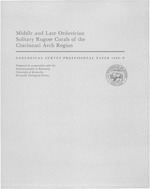Middle Ordovician (Kirkfieldian) solitary rugose corals have been reported from the Tyrone Limestone of the High Bridge Group and the Curdsville Limestone Member of the Lexington Limestone in central Kentucky. Lambeophyllum? spp. A and B are recognized in the Tyrone Limestone.
Grewingkia canadensis (Billings, 1862) and Streptelasma divaricans (Nicholson, 1875b) are the only solitary Rugosa known from the Upper Ordovician in the Cincinnati Arch region of Kentucky-Indiana-Ohio. Their earliest occurrence suggests introduction during an early Richmondian transgression. The two species have similar distributions; they favored normal marine waters of intermediate depth where calcium carbonate sediments accumulated and brachiopods and bryozoans thrived. G. canadensis probably lived in stable, low-energy environments, but the corals were transported during higher energy conditions before final deposition and rapid burial. S. divaricans was epifaunal on stabilized carbonate substrates during periods of nondeposition. Energy conditions remained low, and subsequent, usually argillaceous sediments often buried these corals in growth position. G. canadensis and S. divaricans attained their greatest diameter and length, respectively, on the southwestern side of the Cincinnati Arch region. The average number of septa in G. canadensis generally increased during Richmondian time, and simpler axial regions became more predominant in both species. These trends may be related to decreasing water depth.
G. canadensis and S. divaricans are confined to the Richmond Solitary Coral Province, which formed a narrow belt extending from the Nashville Dome, along the Cincinnati Arch region to northern Michigan, and through southern Ontario and Quebec. The Red River-Stony Mountain Solitary Coral Province occupied the remainder of North America during the Richmondian. Because the taxa in these provinces are different, solitary corals cannot now be used to correlate strata outside the geographically restricted Richmond Province with the North American Upper Ordovician type sections in the Cincinnati Arch region. G. canadensis and S. divaricans became extinct during regression of the epicontinental sea at the end of Richmondian time.


